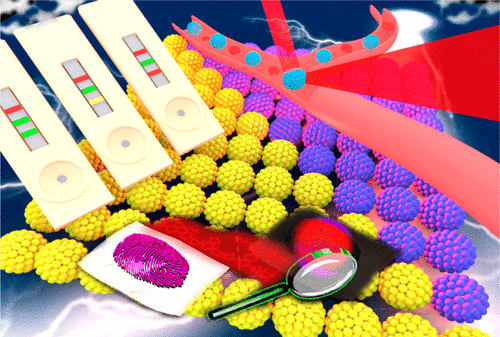当前位置:
X-MOL 学术
›
ACS Appl. Bio Mater.
›
论文详情
Our official English website, www.x-mol.net, welcomes your
feedback! (Note: you will need to create a separate account there.)
Recent Developments in Semiconducting Polymer Dots for Analytical Detection and NIR-II Fluorescence Imaging
ACS Applied Bio Materials ( IF 4.6 ) Pub Date : 2020-11-19 , DOI: 10.1021/acsabm.0c01185 Meenakshi Verma, Yang-Hsiang Chan, Sampa Saha, Ming-Ho Liu
ACS Applied Bio Materials ( IF 4.6 ) Pub Date : 2020-11-19 , DOI: 10.1021/acsabm.0c01185 Meenakshi Verma, Yang-Hsiang Chan, Sampa Saha, Ming-Ho Liu

|
In recent years, semiconducting polymer dots (Pdots) have attracted enormous attention in applications from fundamental analytical detection to advanced deep-tissue bioimaging due to their ultrahigh fluorescence brightness with excellent photostability and minimal cytotoxicity. Pdots have therefore been widely adopted for a variety types of molecular sensing for analytical detection. More importantly, the recent development of Pdots for use in the optical window between 1000 and 1700 nm, popularly known as the “second near-infrared window” (NIR-II), has emerged as a class of optical transparent imaging technology in the living body. The advantages of the NIR-II region over the traditional NIR-I (700–900 nm) window in fluorescence imaging originate from the reduced autofluorescence, minimal absorption and scattering of light, and improved penetration depths to yield high spatiotemporal images for biological tissues. Herein, we discuss and summarize the recent developments of Pdots employed for analytical detection and NIR-II fluorescence imaging. Starting with their preparation, the recent developments for targeting various analytes are then highlighted. After that, the importance of and latest progress in NIR-II fluorescence imaging using Pdots are reported. Finally, perspectives and challenges associated with the emergence of Pdots in different fields are given.
中文翻译:

用于分析检测和 NIR-II 荧光成像的半导体聚合物点的最新进展
近年来,半导体聚合物点(Pdots)因其超高荧光亮度、优异的光稳定性和极小的细胞毒性而在从基础分析检测到先进的深层组织生物成像的应用中引起了极大的关注。因此,聚合物点已被广泛用于各种类型的分子传感,用于分析检测。更重要的是,最近开发的用于 1000 至 1700 nm 之间光学窗口的 Pdots,俗称“第二近红外窗口”(NIR-II),已成为生活中的一类光学透明成像技术。身体。NIR-II 区域在荧光成像中优于传统 NIR-I (700–900 nm) 窗口的优势源于减少的自发荧光、最小的光吸收和散射,并提高穿透深度,以产生生物组织的高时空图像。在此,我们讨论和总结了用于分析检测和 NIR-II 荧光成像的 Pdots 的最新发展。从它们的制备开始,然后重点介绍针对各种分析物的最新发展。之后,报告了使用 Pdots 进行 NIR-II 荧光成像的重要性和最新进展。最后,给出了与 Pdots 在不同领域出现相关的观点和挑战。之后,报告了使用 Pdots 进行 NIR-II 荧光成像的重要性和最新进展。最后,给出了与 Pdots 在不同领域出现相关的观点和挑战。之后,报告了使用 Pdots 进行 NIR-II 荧光成像的重要性和最新进展。最后,给出了与 Pdots 在不同领域出现相关的观点和挑战。
更新日期:2020-11-19
中文翻译:

用于分析检测和 NIR-II 荧光成像的半导体聚合物点的最新进展
近年来,半导体聚合物点(Pdots)因其超高荧光亮度、优异的光稳定性和极小的细胞毒性而在从基础分析检测到先进的深层组织生物成像的应用中引起了极大的关注。因此,聚合物点已被广泛用于各种类型的分子传感,用于分析检测。更重要的是,最近开发的用于 1000 至 1700 nm 之间光学窗口的 Pdots,俗称“第二近红外窗口”(NIR-II),已成为生活中的一类光学透明成像技术。身体。NIR-II 区域在荧光成像中优于传统 NIR-I (700–900 nm) 窗口的优势源于减少的自发荧光、最小的光吸收和散射,并提高穿透深度,以产生生物组织的高时空图像。在此,我们讨论和总结了用于分析检测和 NIR-II 荧光成像的 Pdots 的最新发展。从它们的制备开始,然后重点介绍针对各种分析物的最新发展。之后,报告了使用 Pdots 进行 NIR-II 荧光成像的重要性和最新进展。最后,给出了与 Pdots 在不同领域出现相关的观点和挑战。之后,报告了使用 Pdots 进行 NIR-II 荧光成像的重要性和最新进展。最后,给出了与 Pdots 在不同领域出现相关的观点和挑战。之后,报告了使用 Pdots 进行 NIR-II 荧光成像的重要性和最新进展。最后,给出了与 Pdots 在不同领域出现相关的观点和挑战。











































 京公网安备 11010802027423号
京公网安备 11010802027423号